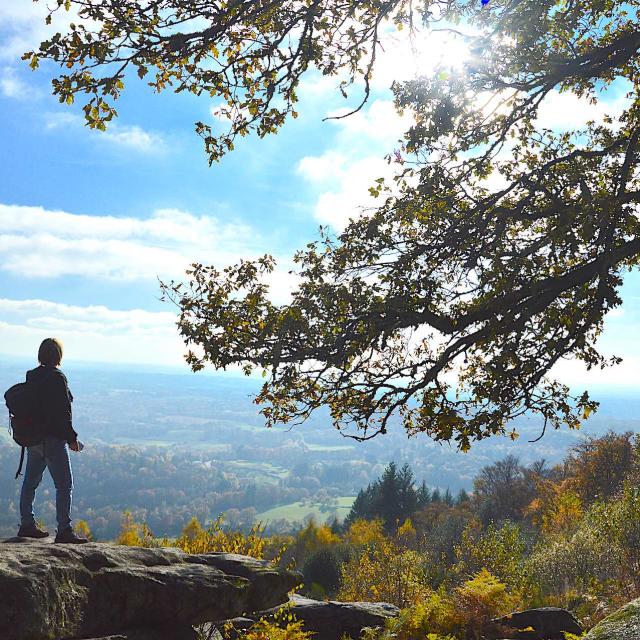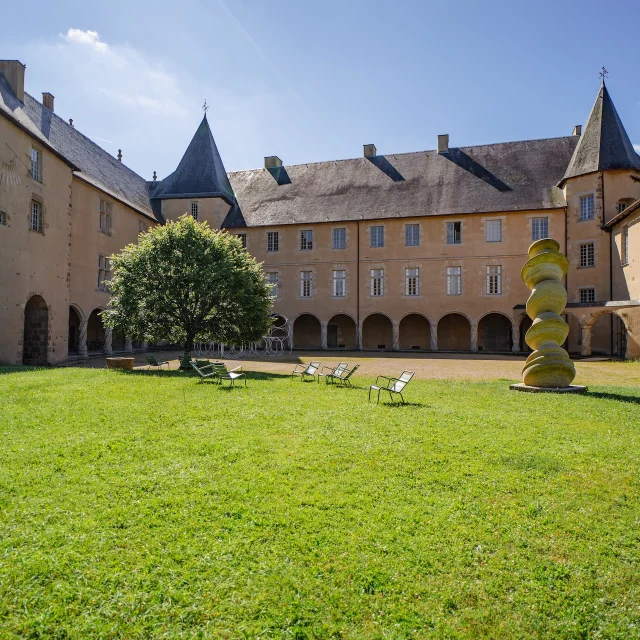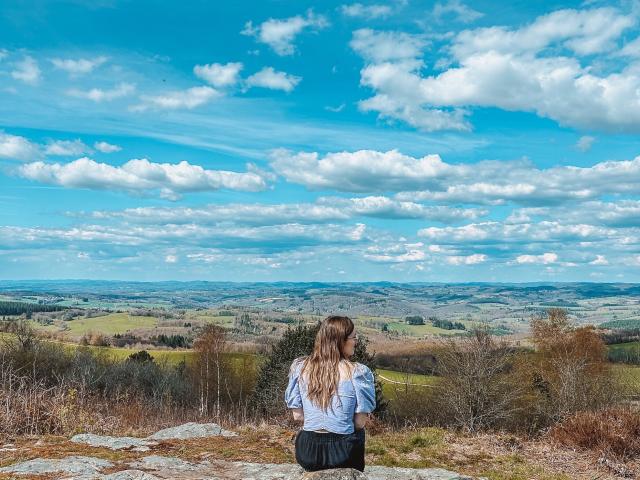 Mont Gargan
Mont Gargan 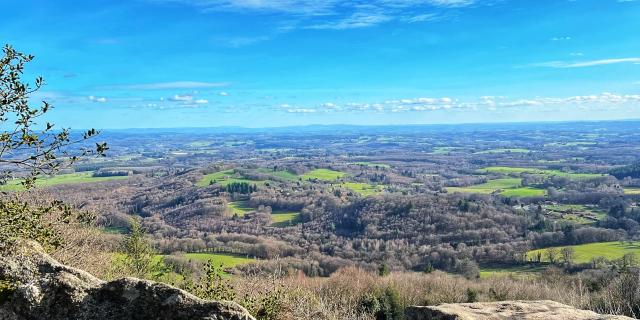 Point de vue du haut de la Pierre Branlante
Point de vue du haut de la Pierre Branlante  Mont Gargan
Mont Gargan 1. The Mont Gargan
A breathtaking panoramaAt any time of day, this place will amaze you with its beauty, its panorama and its history ✨
Once you’ve reached the summit, from its 731-meter altitude you’ll be able to admire the remains of the Notre Dame de Bon Secours chapel indeed, this place was the scene of clashes between resistance fighters and the Germans during the Second World War.
It’s a beautiful place where you can discover heather moors, superb alleys of hundred-year-old beech trees and religious remains dating back to the 19th century.
Don’t forget to stop at the orientation table and admire the view of the Millevaches plateau and the Monédières massif 👀
2. The Château de Châlucet
A perfect place for family outingsLocated in Saint-Jean-Ligoure, the Château de Châlucet is built on a rocky promontory that dominates the surrounding landscape. Today, it is a major part of the Limousin 🏰 heritage.
During your visit, you can explore its ruins, old perched staircases, crumbled towers and hidden passageways.
Watch out, you’re about to step into the former home of lords and brigands 🤭
Our little tip: climb to the very top of the Tour Jeannette for a spectacular view of the whole estate.
To all our adventurers, what are you waiting for to conquer this place? 🥾
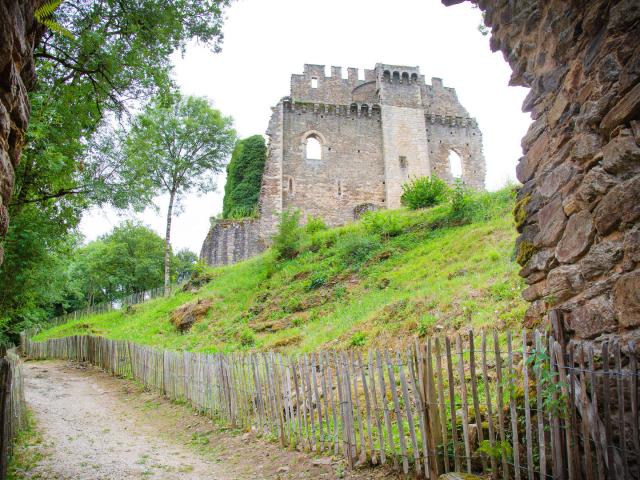 Département Haute Vienne 87 - Château Châlucet 2022 - Maxime Authier
Département Haute Vienne 87 - Château Châlucet 2022 - Maxime Authier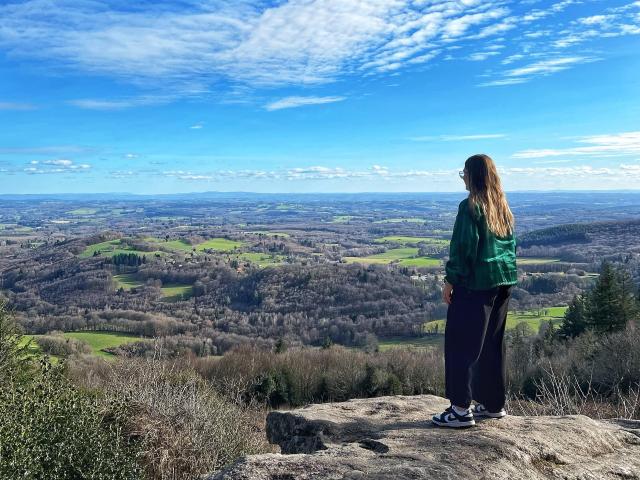 Pierre Branlante
Pierre Branlante3. The Wobbly Stone
Our best look LimousinHead for Saint-Léger la Montagne, to discover a breathtaking view considered one of the most beautiful in the Haute-Vienne 🤩
This gigantic rocky chaos perched at an altitude of 650 m allows you to see 300 m below, the market town of La Jonchère-Saint-Maurice.
A little higher up, at 701 m, is Puy de Sauvagnac, the highest point of the Monts d’Ambazac.
Like many stones in the region, there are legends attached to it. Do you know them? 😉
If not, we’ll tell you a little anecdote about this magical place.
Locals say that this rock once served as a court of law: if an accused person could move the stone, he or she would be declared innocent.
4. The Corot site
Nature's eternal beautyNot far from Saint-Junien town center, come and discover the Site Corot for a rejuvenating break, a family picnic, a jog or a walk…👒🍃
Popular with hikers, anglers and geocaching enthusiasts… This spot is the starting point for hikes of all levels.
As you stroll along, discover the valley’s flora and fauna and let yourself be charmed by this river winding between the rocks in an exceptional landscape 🌞
This site takes its name from the painter Jean-Baptiste Corot, who is said to have found inspiration in the beauty of the landscape.
 Département Haute Vienne 87 - Site Corot - Saint Junien 2022 - Maxime Authier
Département Haute Vienne 87 - Site Corot - Saint Junien 2022 - Maxime Authier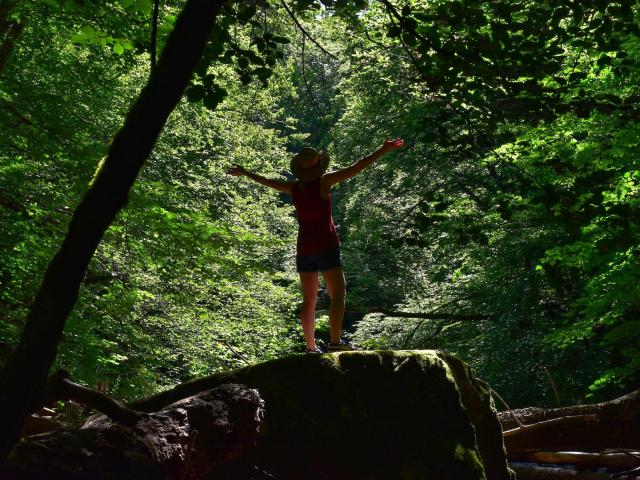 Saut de la Brame
Saut de la Brame5. The Saut de la Brame
The impetuous waterfallLe Saut de la Brame, a magical site: river, rocks and majestic trees, everything you need to reconnect with nature 🪷
The rather impetuous Brame River flows through a winding, steep-sided valley. Upstream from the confluence with the Gartempe, three three-metre-high waterfalls form the Saut de la Brame.
Downstream, the widened valley and boulders of all sizes cause eddies and small waterfalls.
Various protected botanical species can be found here, as well as numerous animal species, some of them very rare, so keep your eyes peeled for a glimpse 👀
For hikers, there’s a signposted walk of around 2 km to take full advantage of this site 🥾
6. Tourbière des Dauges
A preserved nature reserveThe Dauges peat bog is a nature reserve that can be explored on a signposted discovery trail in Saint Léger la Montagne.
You’ll walk close to marshes, peat bogs and peat moors.
Would you like to learn more about its history? 🤗
Don’t move we’ll tell you all about it!
The peat bog is a depression that began to deepen 3 million years ago. For more than 10,000 years, cold and humidity have prevented plants from decomposing there. The result is a highly fertile deposit known as “peat”, which in places reaches over 3 metres in height.
The discovery trail takes in almost 200 hectares of remarkable flora and fauna: almost 300 species of butterfly, over 200 species of beetle, numerous species of bird, rare mosses and lichens, and some very interesting plants.
As an added bonus, don’t hesitate to download the Explor Games app, which will guide you, apprentice explorers, through the undergrowth and adventurous, spongy crossings with your feet in the peat.
 Tourbières des Dauges
Tourbières des Dauges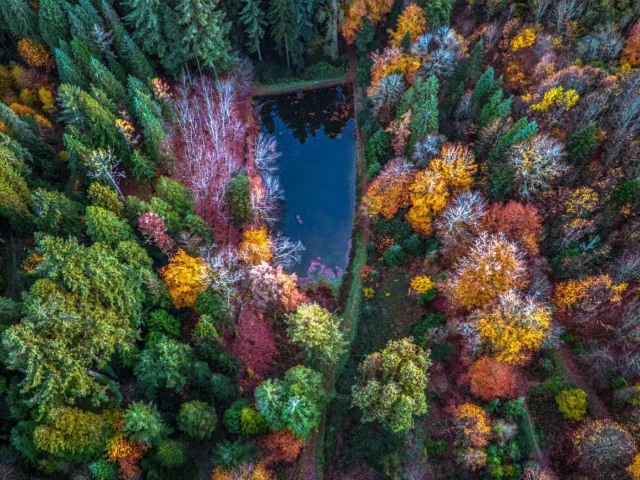 Arboretum La Jonchere St Maurice
Arboretum La Jonchere St Maurice7. The Arboretum
Remarkable natural siteThe creation of the arboretum began in 1884, although it was originally a nursery. 🌳
The owner, who teamed up with a horticulturist, brought back all sorts of gigantic tree species from his travels, including redwoods and purple beeches, which he had planted to see if they could survive in this environment. In 1990, the ONF (Office National des Forêts) became the manager of this natural area, and it was then that the nursery was transformed into an arboretum open to the public!
Stroll through its 7 hectares to admire remarkable century-old trees, a rich and protected biodiversity and a built heritage comprising low walls, a fountain, a pond… dating back to 1884.
An emblematic Haute-Vienne site with an exceptional heritage, this rejuvenating and soothing green setting is one of the very first in France with genuine landscape, botanical and tourist interest. 🍃
Impressive in its beauty and remarkable landscape, it’s a must-see for nature lovers!
This enchanting place, perfect for strolling and daydreaming, can be visited freely in any season. ✨
8. The Viaduc de Rocherolles
In a special natural settingLocated in the commune of Folles and Bersac-sur-Rivalier, the Viaduc de Rocherolles is a railway bridge built over the Gartempe river.
At 54.60 metres high and 180 metres long, with 12 arches spread over 2 levels, the Viaduct overlooks the surrounding landscape. It required the skills of 2,000 workers over some 2 years (from 1852 to 1854) to build. The bridge was designed using granite blocks extracted from nearby quarries and cut on site. The bridge, the highest in France at the time, cost the Paris-Orléans railway company one and a half million gold francs. The first train crossed the bridge on June 24, 1856.
Located in a protected area, the bridge boasts a wealth of flora and fauna. Numerous plants with an Atlantic and mountain influence cohabit here. 🌺
Volunteers from Natura and Nature et Patrimoine have even set up a botanical discovery trail along the Gartempe River. Walkers can discover the many curiosities of this area. 🤩
 Viaduc de Rocherolles - @sly_drone
Viaduc de Rocherolles - @sly_drone Jardin de l'Évêché Itinera Magica - Foehn Photographie
Jardin de l'Évêché Itinera Magica - Foehn Photographie9. Jardin Botanique de l'Évêché
A French garden in a historic settingThe Jardin de l’Évêché, located in the heart of Limoges’ historic Cité district, extends over 5 hectares. It comprises 6 terraces laid out on the slopes of Puy Saint-Etienne during the construction of a new episcopal palace at the end of the 18th century ✨
Purchased by the city in 1910, this complex was gradually redeveloped.
In the 1950s, the gardens served as an observation area for students of the Faculty of Pharmacy.
The space is divided into three main categories: a formal garden, a large esplanade embellished by a pond and a grove of lime trees, and a vast botanical garden housing over 3,000 plants classified into 3 different themes.
The systemic garden, where plants are classified by family, the theme garden, where plants are classified according to their properties, and an ecological area recreating the five regional natural environments typical of the Limousin.
A calm, soothing and instructive place, the walker can venture here in all seasons and admire from the various terraces a remarkable view of the banks of the Vienne 🥰
10. The Château de Montbrun
A beautiful Upper Viennese buildingA military fortress built on the banks of a small river in the 12th and 15th centuries, this handsome, timeless structure stands at the bottom of a verdant valley, 7 km from Châlus.
The Château de Montbrun was burnt down and destroyed in 1385, before being rebuilt in its present form in the 15th century by Pierre Montbrun, bishop of Limoges 🏰
Much damaged and worn by time, particularly by the fire of 1917, it has retained its four large towers, one of which encompasses the “Grand Jacques”, a superb quadrangular keep, one of the finest examples of its kind.
If you keep your eyes open, the motte castrale, the site’s original fortification, can be seen a short distance away. Don’t hesitate, you can visit it and even take advantage of its signposted Nordic walking trail 👀🌿
Reflecting in its moat-like pond, this château is undoubtedly one of the most beautiful and picturesque monuments in the Limousin, and an unquestionable site to stroll around in Haute-Vienne!
And what would you say if we asked you what your favorite place in Haute-Vienne was? 😉
 Château de Montbrun - @mathilde_rlb
Château de Montbrun - @mathilde_rlb